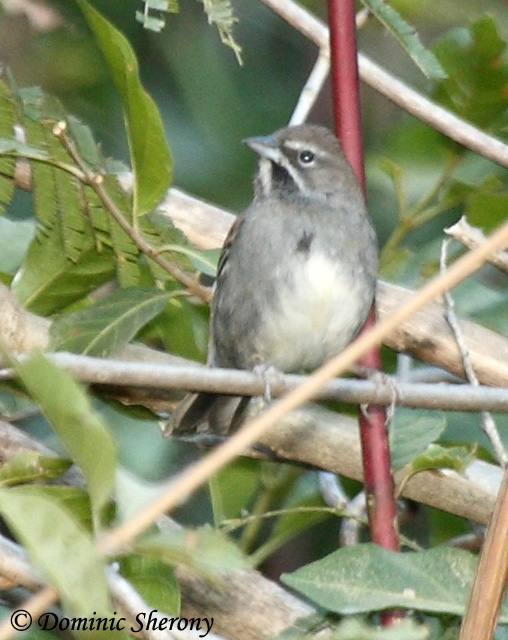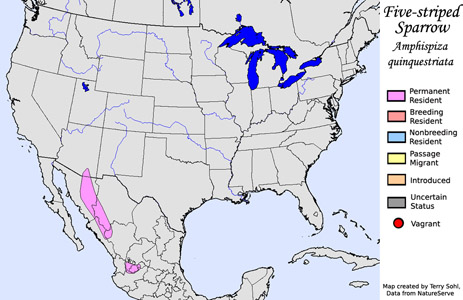| Length: 6 inches | Wingspan: 8 inches | Seasonality: Non-resident in South Dakota |
| ID Keys: Heavily striped facial pattern, dark gray overall with lighter underparts, dark brownish upperparts | ||
 The
Five-striped Sparrow is a species with a small range in western Mexico and
far southern Arizona. They can be relatively common in their small
geographic range, but observing the birds is another matter, as they
generally forage in dense vegetation. They are most easily observed
when the male perches in a relatively open location to sing his song in the
spring. Five-striped Sparrows were unknown in the United States until
the 1950s, when nesting birds were found in several locations in far
southern Arizona. The birds may have expanded their range to the north
in recent decades, or the preferred habitat and the birds' habits may have
just made them an unseen presence in Arizona until "found" in the 1950s.
The
Five-striped Sparrow is a species with a small range in western Mexico and
far southern Arizona. They can be relatively common in their small
geographic range, but observing the birds is another matter, as they
generally forage in dense vegetation. They are most easily observed
when the male perches in a relatively open location to sing his song in the
spring. Five-striped Sparrows were unknown in the United States until
the 1950s, when nesting birds were found in several locations in far
southern Arizona. The birds may have expanded their range to the north
in recent decades, or the preferred habitat and the birds' habits may have
just made them an unseen presence in Arizona until "found" in the 1950s.
Habitat: Found in areas of dense shrubbery and ocotillo in the Arizona portion of their range, particularly where such vegetative cover is found on sloped hillsides. They use similar habitat as well as dry open woods in the Mexican part of their range.
Diet: Feeds heavily on insects and other small invertebrates during the summer months. They will also feed on berries and seeds, with vegetative matter perhaps making up a larger portion of the diet during the winter months when insects are less available.
Behavior: Most foraging is done by walking along the ground or hopping through low vegetation.
Nesting: The nest of a Five-striped Sparrow is a deep cup of grasses, placed in vegetative cover such as in a thick clump of grass, a dense shrub, or in other dense vegetation. The female usually lays 3 or 4 eggs and she alone incubates them. When the eggs hatch, both parents help to feed the young. The young leave the nest after about 10 days, but typically are continued to be cared for by the parents for at least two weeks after fledging.
Song: Song of a Five-striped Sparrow is series of short, high-pitched, gurgling phrases.
Migration: Considered a permanent resident throughout its normal range. However, those found in southern Arizona typically are much more common in summer than in winter, indicating that some migration of the northern populations may occur.
Interactive eBird Map: Click here to access an interactive eBird map of Five-striped Sparrow sightings
Similar Species: Sage Sparrow, Black-throated Sparrow
Conservation Status: Populations appear to be relatively stable. The IUCN lists the Five-striped Sparrow as a species of "Least Concern".
Further Information: 1) BirdLife International - Five-striped Sparrow
2) Maricopa Audubon Society - Five-striped Sparrow
3) Audubon.org - Five-striped Sparrow
Photo Information: Photo taken by Dominic Sherony - February 15th, 2009 - Zacatecas, Mexico - Photo licensed under Creative Commons Attribution ShareAlike 2.0 Generic License.
| Click below for a higher-resolution map |
 |
| South Dakota Status: Non-resident in South Dakota |
Additional Five-striped Sparrow Photos (coming soon!!)
